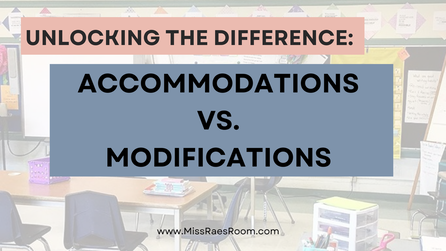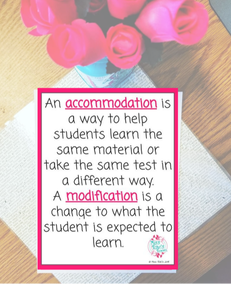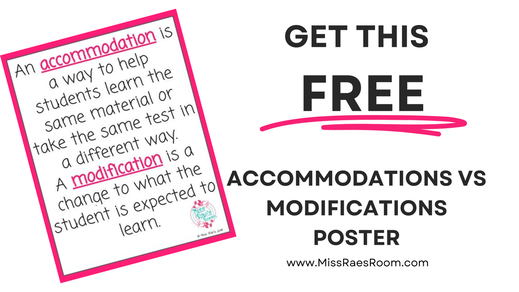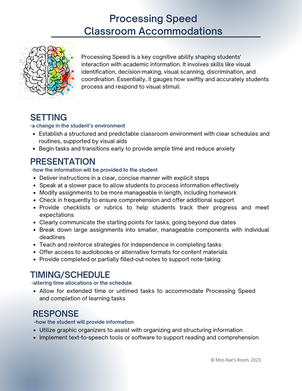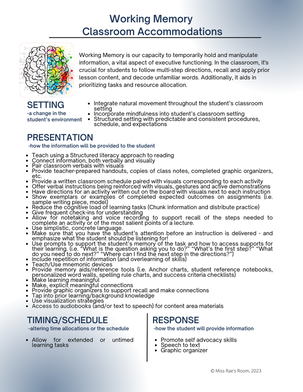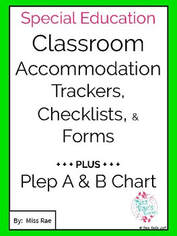Unlocking the Difference: Accommodations vs. Modifications
In the labyrinth of supporting students with disabilities, Individualized Education Program (IEP) accommodations and modifications serve as guiding beacons, illuminating pathways to inclusive education. Yet, amidst the bustle of classrooms, these terms often dance interchangeably in teachers' lexicons, blurring the lines of their distinct purposes.
|
IEP accommodations and modifications are essential supports provided for students with disabilities. These terms are often used interchangeably by teachers, but they are different.
So what really is the difference between an ACCOMMODATION and a MODIFICATION? Aren't they the same thing? No. Accommodations and modifications are different from each other! |
Accommodations
Accommodations aim to ensure access to the general education curriculum by addressing barriers or challenges, leveling the educational playing field for full participation. These adjustments primarily focus on altering the presentation of information and the methods through which students demonstrate their knowledge or skills while maintaining the integrity of curriculum content and standards.
An accommodation is a way to help students learn the same material or take the same test in a different way.
For example...
An accommodation is a way to help students learn the same material or take the same test in a different way.
For example...
- Shorten the number of problems
- Material is read aloud
- Multiple choice test instead of essay assessment (but assessing same content)
|
But let's zoom in further. Accommodations unfurl into distinct categories, each tailored to meet specific needs. From altering how information is presented to adjusting response formats, timing, or environmental settings—each tweak strives to foster inclusivity in the classroom.
Presentation: Presentation accommodations seek to provide access to the materials and content being shared so that students with disabilities can effectively participate in the learning experience. These accommodations are a change in how the information will be provided to the student. |
ex. student will be provided with a copy of class notes
Response: The aim of response accommodations is to provide support to students with disabilities in effectively communicating their knowledge and ideas.
These accommodations are a a change in how the student will provide information.
ex. graphic organizers for written expression
Timing/Scheduling: Timing/Scheduling accommodations are designed to address the specific needs of students with disabilities regarding the pace, duration, and organization of their learning activities.
These accommodations alter time allocations or the schedule (i.e. extra time, at a specific time of day, etc.).
ex. extended time for tests
Setting: Setting accommodations aim to create an inclusive and accessible environment that promotes learning and participation.
These accommodations make a change in the student's environment.
ex. access to adaptive furniture such as a standing desk; visual supports such as a visual timer
Response: The aim of response accommodations is to provide support to students with disabilities in effectively communicating their knowledge and ideas.
These accommodations are a a change in how the student will provide information.
ex. graphic organizers for written expression
Timing/Scheduling: Timing/Scheduling accommodations are designed to address the specific needs of students with disabilities regarding the pace, duration, and organization of their learning activities.
These accommodations alter time allocations or the schedule (i.e. extra time, at a specific time of day, etc.).
ex. extended time for tests
Setting: Setting accommodations aim to create an inclusive and accessible environment that promotes learning and participation.
These accommodations make a change in the student's environment.
ex. access to adaptive furniture such as a standing desk; visual supports such as a visual timer
Modifications
Modifications, on the other hand, are tailored changes made to the curriculum, instruction, or assessment to directly suit individual needs. They involve adapting curriculum content to emphasize key concepts, simplifying material, reducing the complexity of assignments, and providing alternative assessments, all aligned with the student's abilities and learning objectives.
Accommodations should support students independent access to the curriculum. Accommodations are essentially a way to differentiate curriculum and instruction for all students.
Modifications fundamentally change the curriculum. Modifications are ONLY for those students who require a specially designed instruction that modifies -or fundamentally-changes the curriculum.
Accommodations should support students independent access to the curriculum. Accommodations are essentially a way to differentiate curriculum and instruction for all students.
Modifications fundamentally change the curriculum. Modifications are ONLY for those students who require a specially designed instruction that modifies -or fundamentally-changes the curriculum.
Modifications can be further divided into categories to help us more effectively use student data to make determinations.
Content: These modifications seek to alter the general education curriculum to match the student’s abilities and learning needs. Modifications fundamentally alter the curriculum
ex. modified reading level; simpler vocabulary; assignments that focus on entry points to the curriculum
Instruction: These modifications seek to alter the general education instruction to match the student’s abilities and learning needs.
ex. direct, explicit instruction given alternative instructional materials (i.e. Wilson Reading System)
Student Output: These modifications adapt or adjust the expectations of how the student demonstrates their knowledge and skills. These modifications focus on showing what a student knows in ways that suit their individual needs and abilities.
ex. Alternate response formats such as orally responded to written responses; offer alternate assignments; partial completion
Yet, even within modifications, diversity reigns supreme. Whether tweaking curriculum content, instructional approaches, or avenues for student output, the goal remains steadfast: to sculpt learning experiences that resonate with each student's strengths and needs.
In this ever-evolving landscape, educators wield these tools with precision, carving out pathways to learning that honor diversity and nurture potential. Armed with a nuanced understanding of accommodations and modifications, they embark on a quest for educational equity, where every student's journey is met with tailored support and boundless opportunities for growth.
So, fellow educators, let us embark on this journey together—armed not only with knowledge but with a steadfast commitment to inclusivity and the transformative power of education.
Unlock the power of accommodations and modifications with my comprehensive teacher resources!
Dive into my blog for expert insights on determining the right supports for your students by clicking HERE.
Access tools for tracking student progress and utilizing accommodations effectively in my Special Education Teacher Binder.
Empower your inclusive teaching journey today with Miss Rae Room's invaluable resources!
By: Miss Rae
Content: These modifications seek to alter the general education curriculum to match the student’s abilities and learning needs. Modifications fundamentally alter the curriculum
ex. modified reading level; simpler vocabulary; assignments that focus on entry points to the curriculum
Instruction: These modifications seek to alter the general education instruction to match the student’s abilities and learning needs.
ex. direct, explicit instruction given alternative instructional materials (i.e. Wilson Reading System)
Student Output: These modifications adapt or adjust the expectations of how the student demonstrates their knowledge and skills. These modifications focus on showing what a student knows in ways that suit their individual needs and abilities.
ex. Alternate response formats such as orally responded to written responses; offer alternate assignments; partial completion
Yet, even within modifications, diversity reigns supreme. Whether tweaking curriculum content, instructional approaches, or avenues for student output, the goal remains steadfast: to sculpt learning experiences that resonate with each student's strengths and needs.
In this ever-evolving landscape, educators wield these tools with precision, carving out pathways to learning that honor diversity and nurture potential. Armed with a nuanced understanding of accommodations and modifications, they embark on a quest for educational equity, where every student's journey is met with tailored support and boundless opportunities for growth.
So, fellow educators, let us embark on this journey together—armed not only with knowledge but with a steadfast commitment to inclusivity and the transformative power of education.
Unlock the power of accommodations and modifications with my comprehensive teacher resources!
Dive into my blog for expert insights on determining the right supports for your students by clicking HERE.
Access tools for tracking student progress and utilizing accommodations effectively in my Special Education Teacher Binder.
Empower your inclusive teaching journey today with Miss Rae Room's invaluable resources!
By: Miss Rae
